Configuración de Canales y Salidas

La Configuración de Mezclador Predeterminada
El RØDECaster Pro II tiene nueve entradas separadas para conectar una amplia gama de dispositivos y fuentes de audio: cuatro conectores combo para conectar micrófonos, instrumentos y otros dispositivos, dos receptores inalámbricos para emparejarse con transmisores inalámbricos compatibles de la serie RØDE IV (como el Wireless GO II y el Wireless ME), un canal Bluetooth para conectar computadoras y dispositivos móviles de forma inalámbrica, el canal SMART pad, y dos interfaces USB-C para conectar dos computadoras y dispositivos móviles, además de un canal virtual extra de USB llamado ‘Chat’ para conectar aplicaciones de chat, lo cual es útil para transmisiones en vivo y otras aplicaciones.
Por defecto, estos canales se asignarán a los faders de la siguiente manera (a menos que se indique lo contrario durante el proceso del Asistente de Configuración):
- Fader 1-4: Entradas XLR/TRS 1-4
- Fader 5: Bluetooth
- Fader 6: SMART Pads
- Fader 7: USB 1
- Fader 8: USB 1 Chat
- Fader 9: USB 2
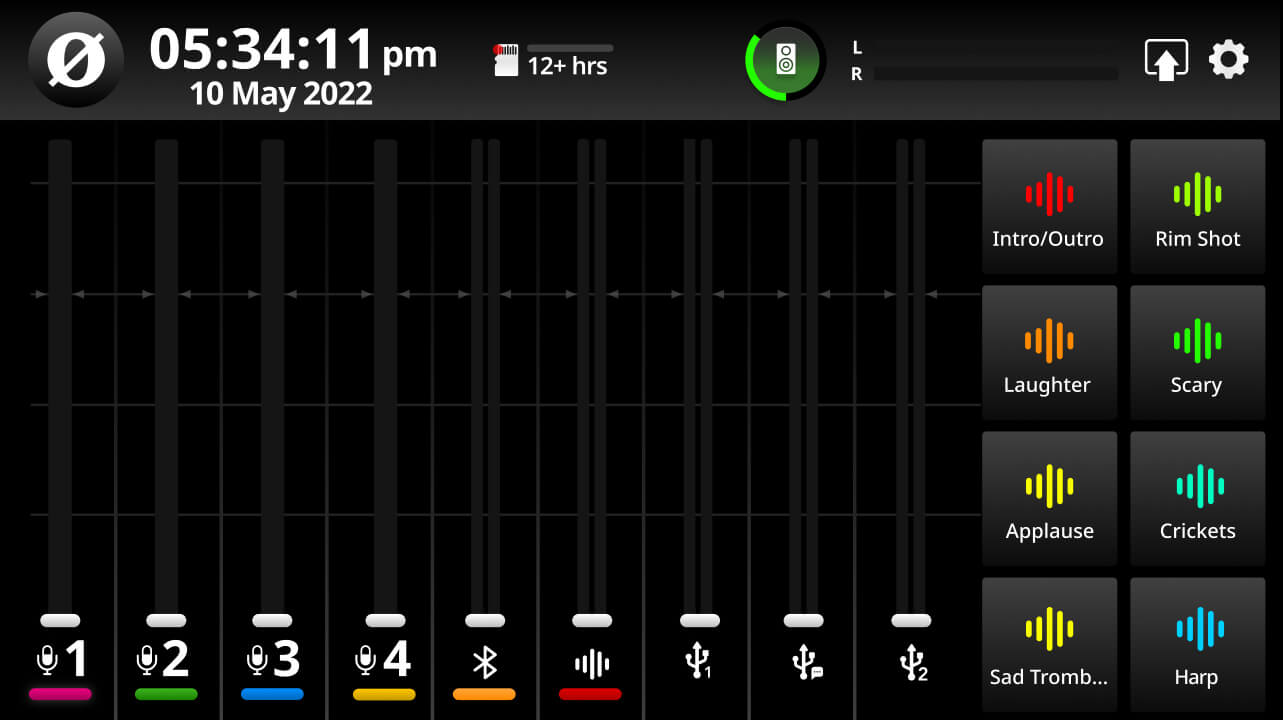
Asignación de Entradas a los Faders
Existen múltiples formas de cambiar la configuración del mezclador. Esto se puede hacer durante el proceso del Asistente de Configuración, o a través de la pantalla de configuración de faders o la pantalla de configuración de canales.
Para acceder a la pantalla de configuración de canales para un fader, simplemente toca el botón encima del fader o el ícono debajo del medidor de nivel, luego toca el ícono de engranaje de configuración para acceder a la pantalla de asignación de canales. Aquí puedes seleccionar qué entrada está asignada a ese canal, desasignar entradas, vincular entradas estéreo y cambiar la codificación por colores del canal. Una vez que hayas configurado el canal, toca el ícono de marca verde para guardar la configuración. Repite el proceso para los otros faders a los que deseas asignar entradas.
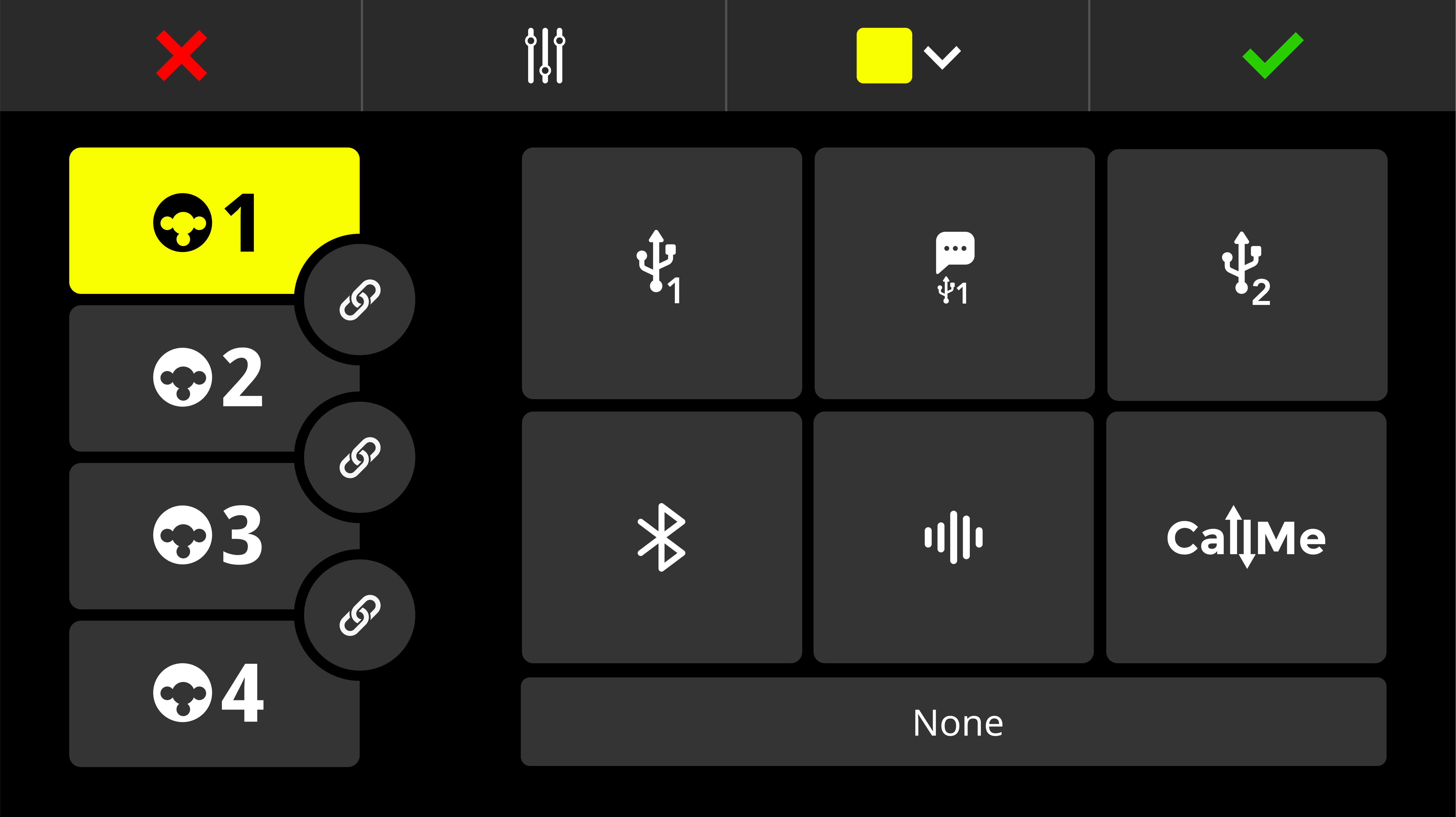
Para acceder a la pantalla de configuración de faders, toca el engranaje de configuración, luego ‘Faders’ (o toca el ícono del fader en la esquina inferior izquierda de la pantalla de configuración del canal). Aquí puedes asignar canales a los faders físicos y virtuales arrastrando y soltando sus íconos en la ubicación deseada utilizando la pantalla táctil. Esta es una forma rápida y fácil de cambiar la configuración del mezclador. También puedes tocar un ícono de fader para acceder a la pantalla de asignación de canales.
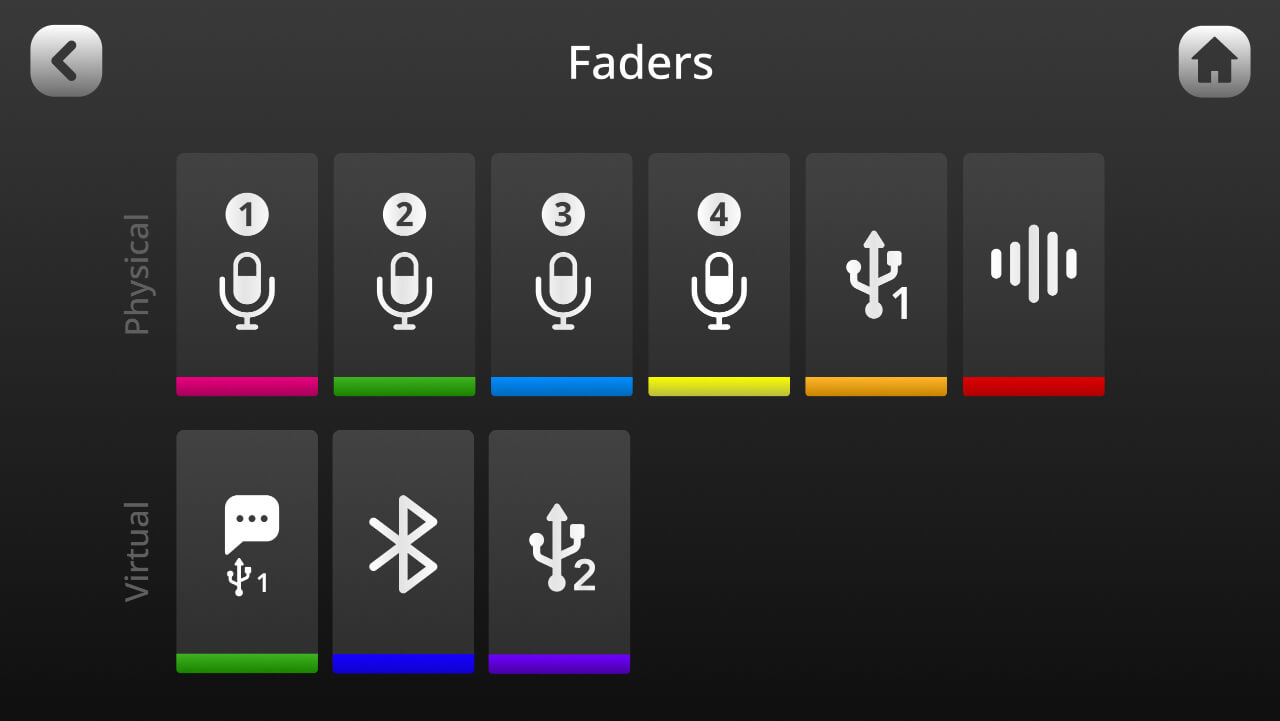
Emparejamiento y Asignación de un Dispositivo Inalámbrico
Para emparejar un dispositivo inalámbrico de la serie RØDE IV (como el Wireless GO II y el Wireless ME) a tu RØDECaster Pro II, accede a la pantalla de configuración del canal presionando el botón físico sobre el fader al que deseas asignar tu dispositivo inalámbrico. En esta pantalla, verás una lista de opciones de micrófono, instrumento y otras entradas que puedes desplazar. Desplázate hacia la izquierda para seleccionar la opción 'Inalámbrico', toca 'Emparejar Nuevo Dispositivo' para entrar en modo de emparejamiento y sigue el proceso de emparejamiento de tu producto para conectar tu dispositivo inalámbrico y asignarlo a esta entrada. Para poner el transmisor Wireless GO II o Wireless ME en modo de emparejamiento, simplemente presiona brevemente su botón de encendido cuando las unidades estén encendidas y no estén emparejadas con otro receptor. La conectividad, grabación, estado de silencio y batería de tu dispositivo se mostrarán en esta pantalla.
 (1).png)
Nota
Asignar cualquiera de los cuatro canales de entrada a la opción ‘Inalámbrico’ anulará la entrada física XLR/TRS asociada, lo que significa que no escucharás ningún audio proveniente de micrófonos o instrumentos conectados a ese canal.
Conectando un micrófono RØDE USB
Puedes conectar un micrófono RØDE USB al puerto USB 2 del RØDECaster Pro II utilizando un cable USB-C-to-C, lo que permite una entrada adicional de micrófono.
Una vez conectado, simplemente asigna el canal USB 2 a un fader y trátalo como si fuera cualquier otro canal de entrada de micrófono. Puedes controlar el procesamiento a bordo del micrófono USB en la pantalla de configuración del canal, aunque el procesamiento y los efectos del propio canal del RØDECaster no se aplicarán. En el caso del PodMic USB, NT-USB Mini, XCM-50 y XDM-100, puedes silenciar o activar el canal USB 2 presionando el botón físico en el micrófono.
Los dispositivos compatibles incluyen:
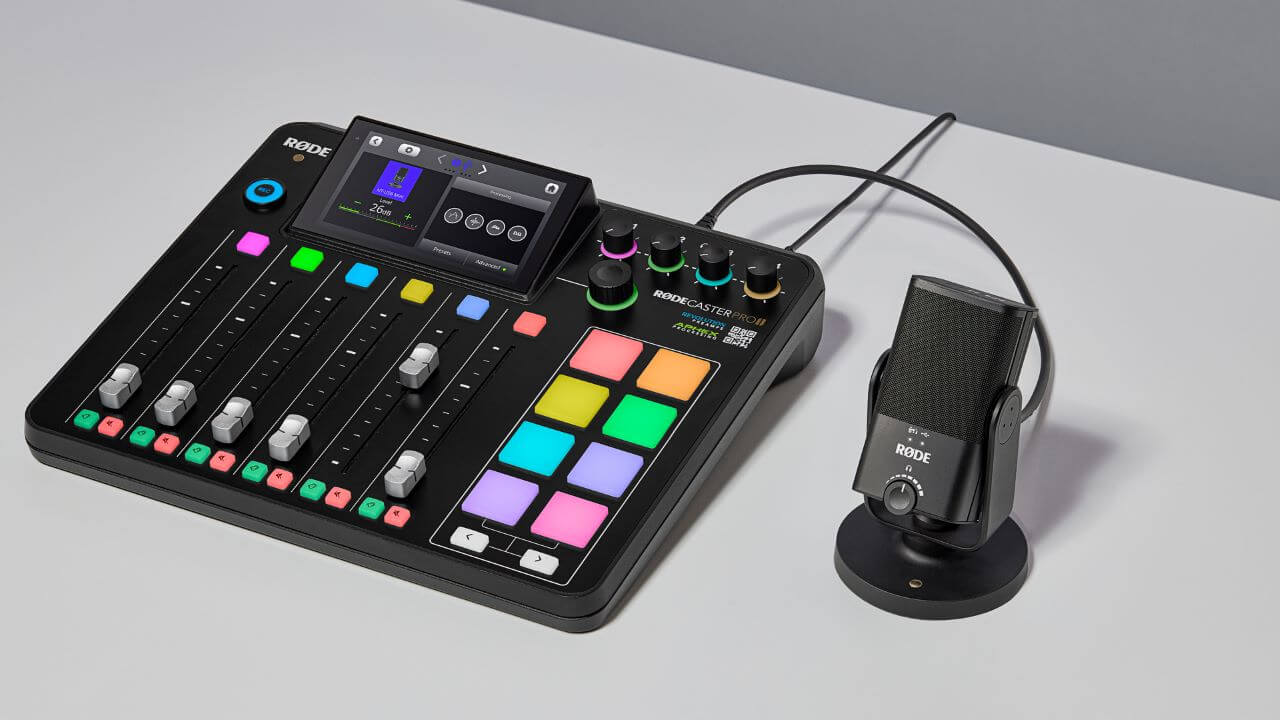
Note
In order to achieve zero-latency monitoring with the USB microphone, you will need to connect headphones directly to the microphone. You can then adjust headphone monitoring levels with the microphone's on-board controls.
Uso de los Faders Físicos y Virtuales
El RØDECaster Pro II cuenta con seis faders físicos de calidad de transmisión y tres faders virtuales, lo que te permite mezclar un total de nueve entradas separadas con un control total y manual. Los faders físicos funcionan como cualquier otro mezclador: simplemente utiliza los deslizadores para ajustar el nivel de ese canal. La posición del fader se reflejará en tiempo real en la interfaz del mezclador.
Los faders virtuales funcionan igual que los faders físicos, solo que tienes un fader digital que se controla tocando el medidor de nivel y luego utilizando el codificador rotativo. También puedes desplazarte fácilmente por los canales virtuales presionando el codificador rotativo. Presionar y mantener el codificador rotativo silenciará el canal virtual seleccionado.
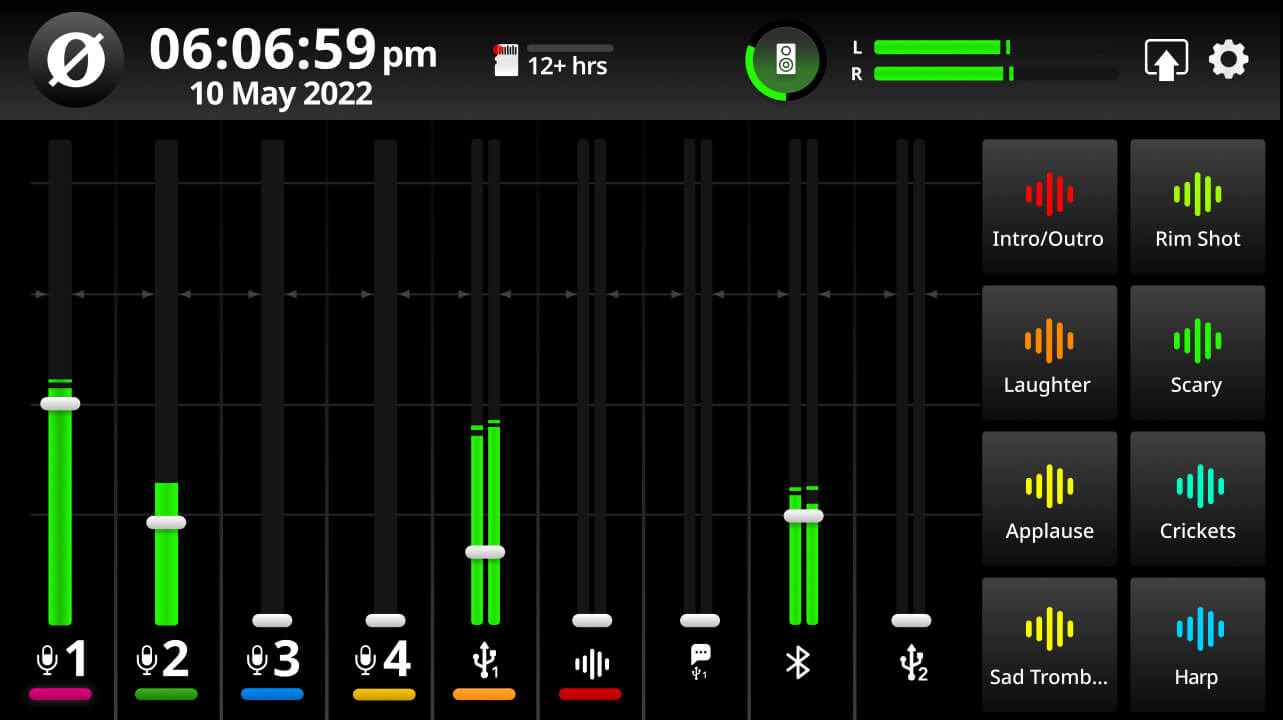
Consejo Profesional
El ‘ganancia unitaria’ para cada fader está indicado por los marcadores blancos en la mesa de mezclas física y las pequeñas flechas en la mesa de mezclas virtual (solo en el modo de medidores de nivel predeterminado). Esto es útil para equilibrar el nivel de entrada con el nivel de salida y es un buen punto de partida al ajustar sus niveles. Si un fader está en ganancia unitaria y la señal sigue siendo demasiado baja, aumente el nivel de ganancia del preamplificador en la pantalla de configuración del canal en lugar de subir más el fader. Esto le ayudará a lograr una señal saludable con un ruido mínimo.
Cambio de la Visualización del Medidor de Niveles
Hay dos formas de mostrar los medidores de niveles en el mezclador virtual: modo ‘Predeterminado’ y modo ‘Transmisión’. En el modo ‘Predeterminado’, hay marcadores a intervalos regulares, lo que te permite visualizar fácilmente tus niveles, así como un marcador para la ganancia de unidad. En el modo ‘Transmisión’, los medidores de niveles incluirán marcadores de dBFS (decibelios a escala completa) así como un medidor de reducción de ganancia (si tienes el compresor activado en ese canal). Para alternar entre los dos modos, ve a configuraciones y luego a ‘Visualización’ > ‘Medición’ y selecciona ‘Predeterminado’ o ‘Transmisión’.

Uso de los Botones de Silencio
El botón rojo debajo de cada uno de los faders físicos del RØDECaster Pro II es un botón de silencio. Esto simplemente silenciará ese canal en la salida. También puedes acceder a un botón de silencio para los tres canales virtuales tocando el medidor de nivel y luego tocando el ícono de silencio, o presionando y manteniendo el codificador rotativo cuando un canal está seleccionado. Cuando un canal está silenciado, el botón y el fader en el mezclador virtual se iluminarán en rojo.
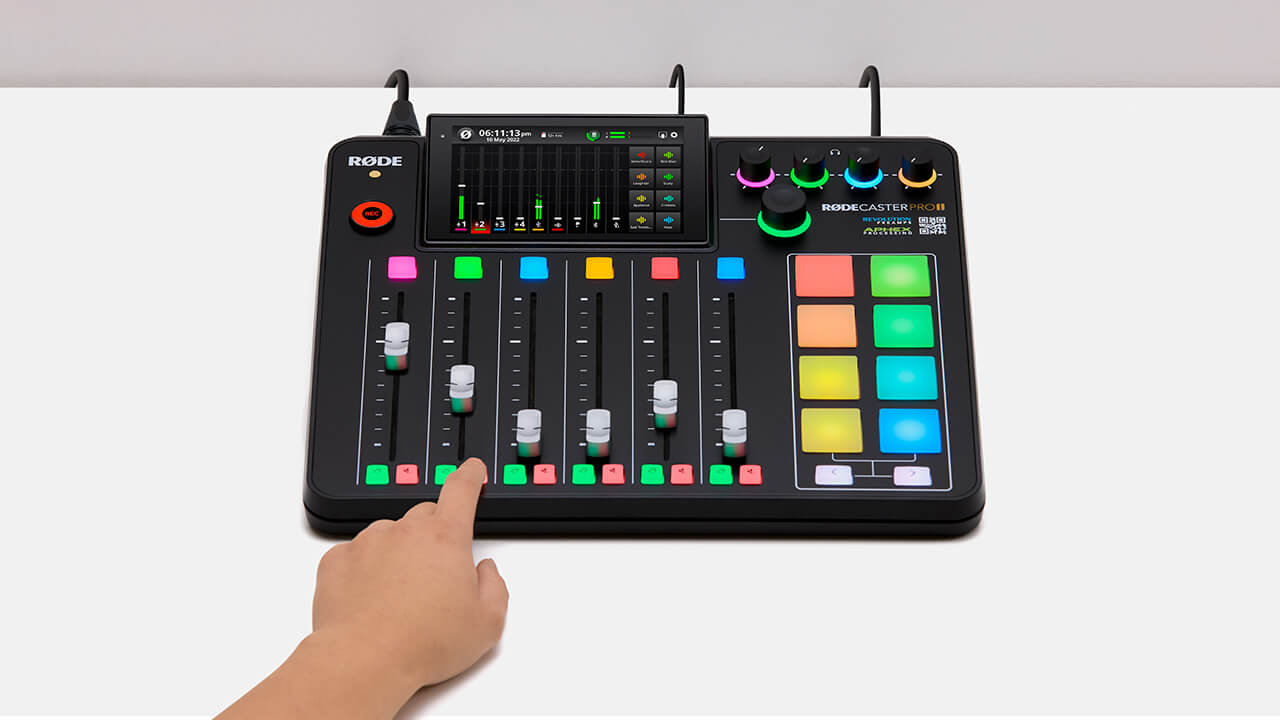
Consejo Profesional
Cuando un canal está silenciado, el audio seguirá llegando en la etapa del preamplificador, pero no se enviará a la salida, lo que significa que aún puedes ajustar el nivel de ganancia en la pantalla de configuración del canal mientras un canal está silenciado, aunque no podrás escucharlo.
Uso de los Botones de Escucha
El botón verde debajo de cada uno de los faders físicos del RØDECaster Pro II es un botón de “escucha” (también conocido como botón de solo). Esto te permite monitorear el audio de un canal por sí solo, sin el resto de la mezcla de audio. También puedes acceder a esta función para los tres canales virtuales tocando el medidor de nivel y luego tocando el ícono de oído.
Hay dos modos diferentes de botón de escucha: ‘Escucha Después del Fader’ y ‘Escucha Antes del Fader’. Para alternar entre estos, ve a configuraciones, luego ‘Salidas’ > ‘Escucha’.
‘Escucha Después del Fader’: Cuando ‘Escucha’ está activado, el anfitrión/productor en el canal de auriculares 1 escuchará el canal al nivel del fader.
‘Escucha Antes del Fader’: Cuando ‘Escucha’ está activado, el anfitrión/productor en el canal de auriculares 1 escuchará el canal a ganancia unitaria, independientemente de la posición del fader.

Note
The solo’d audio will only be heard by the host/producer on headphone channel 1). You can also access this feature for the three virtual channels by tapping the level meter then tapping the ear icon.
Note
Pressing both the listen and mute buttons will activate ‘Back Channel’ mode, allowing the host/producer and guest to communicate “off-air”. This action can also be allocated to a SMART pad – check out the 'Using the SMART Pads' section for more information.
Consejo Profesional
No necesitas seleccionar los botones verdes de escucha para todos los canales que estás utilizando al grabar. Estos son para “escuchar” un canal en particular sin oír el resto del audio. Seleccionar los botones de escucha para todos tus canales puede resultar en que se grabe audio que no esperabas (por ejemplo, si tienes todos tus canales activos en solo usando los botones de escucha, puede que no notes audio que provenga de otro canal porque estará silenciado en tus auriculares, aunque aún así se grabará).
Comprendiendo las Salidas
El RØDECaster Pro II tiene un total de diez salidas de audio. Estas comprenden tanto salidas analógicas, incluyendo las cuatro salidas para auriculares y la salida de monitor estéreo, como salidas digitales, incluyendo el canal Bluetooth, el audio que se graba en la tarjeta microSD incorporada, y las tres salidas USB.
Por defecto, los niveles que establezcas utilizando los faders físicos y virtuales en la mesa de mezclas principal dictarán la mezcla de audio que se envía a todas estas salidas. Sin embargo, también puedes crear sub-mezclas personalizadas para estas salidas (ver más abajo). Esto es particularmente útil para aplicaciones de streaming donde deseas tener control total sobre qué fuentes de audio y niveles de audio se envían a tu transmisión, chat, auriculares y otros destinos de audio. Para los canales que se utilizan para comunicaciones bidireccionales, también puedes configurar la salida como mix-minus para mitigar el eco o el retraso no deseado (ver más abajo para más información).

Creando Submezclas Personalizadas
Para crear una submezcla para cualquier salida, toca el engranaje de configuración en la esquina superior derecha de la pantalla principal del mezclador y luego navega a ‘Salidas’ > ‘Enrutamiento’. Aquí verás un menú con cada una de tus diez diferentes salidas de audio. Toca la salida que deseas configurar y selecciona ‘Personalizado’ en la parte superior de la pantalla.
Niveles: Toca uno de los deslizadores y utiliza el codificador rotativo para ajustar el nivel de un canal de entrada individual hacia arriba o hacia abajo para la submezcla de salida seleccionada.
Vínculos: El botón de ‘vincular’ debajo de cada fader te permite atar el nivel de volumen de ese canal al nivel de la mezcla principal, que son establecidos por los faders físicos y los faders virtuales en la pantalla principal del mezclador. Por defecto, todos los canales están vinculados (indicado por el icono de vínculo blanco con la línea en el centro), pero al tocar este botón se desvincula el fader en la submezcla (icono amarillo sin línea en el centro).
Cuando están vinculados, ajustar niveles individuales en una submezcla creará niveles de compensación que son relativos al fader de la mezcla principal, indicado por la barra azul en el fader. Esto significa que cualquier ajuste de fader en la mezcla principal aumentará o disminuirá el nivel de la submezcla, pero con esta compensación mantenida. Cuando están desvinculados, los niveles de fader en una submezcla no cambiarán cuando el canal asociado se ajuste en la mezcla principal.
Silencios: La tercera opción en el botón de vínculo (una ‘x’ roja) silencia el canal asociado en esta submezcla.

Note
When you select the mute setting on a channel in a sub-mix, this will clear the custom level you had set on that input’s fader and return it to the level set by the main mix).
Mezcla Principal y Mezcla-Menos
Junto con la configuración ‘Personalizada’, en algunas salidas también puedes seleccionar ‘Mezcla Principal’ (que simplemente utiliza los niveles establecidos por los faders físicos y virtuales en la mezcladora principal) o ‘Mezcla-Menos’ para la mezcla de salida. Para las salidas de Bluetooth y USB, la opción ‘Mezcla-Menos’ utiliza la misma configuración que la mezcla principal, pero excluye la entrada del canal seleccionado (la entrada de USB 1 en el canal de salida de USB 1, por ejemplo) para evitar retroalimentación o eco. Consulta nuestras guías sobre conexiones USB y conexión de llamadores en línea para más información sobre la mezcla-menos.
